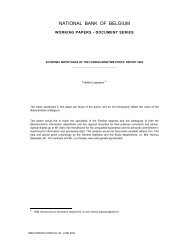Working Paper Research - Nationale Bank van België
Working Paper Research - Nationale Bank van België
Working Paper Research - Nationale Bank van België
You also want an ePaper? Increase the reach of your titles
YUMPU automatically turns print PDFs into web optimized ePapers that Google loves.
esearch work of the Monetary and Economic Department of the BIS, which was under theresponsibility of Lamfalussy.Moreover, growing attention was being paid to the infrastructure of the financial system. October1981 saw the first meeting of a newly established Group of Payment System Experts. In November1990, it was transformed into the Committee on Payment and Settlement Systems (CPSS).Several reports were produced, among them the "Report on Netting Schemes" (February 1989),the "Report of the Committee on Interbank Netting Schemes" (the so-called Lamfalussy Report, asthe group was chaired by Lamfalussy, in November 1990, BIS, 1990) and the Report on "Deliveryversus Payment in Securities Settlement Systems" (September 1992). It is noteworthy that, duringthe financial crisis of 2007-2008, there were no serious problems with the actual financialinfrastructure. The clearing, settlement and payment systems continued to function properly. Thiscontrasted with the "Great Crash" of 1929, when there were recurring problems. For instance, theticker was mostly lagging at the New York Stock Exchange (Galbraith, 1975, p. 133). So, the biginvestments, to enhance the crisis-resistance capabilities of the financial infrastructure, have "beenrewarded by high returns" (Lamfalussy, 2009).In the early 1990s, with EMU looming, Lamfalussy also anticipated that monetary policy issueswould become less important at the level of the G10 Governors. So, he pushed for a further shift infocus at the BIS towards financial stability.6 CONCLUSIONIn this paper, it is argued that Alexandre Lamfalussy, who was at the BIS from 1976 to 1993,played a crucial role in shaping the <strong>Bank</strong>'s view of financial stability, with its attention to the macroprudentialdimension.Alexandre Lamfalussy's early academic work was very much in the Keynesian tradition. It focusedon growth and investment theory and Belgium's and Europe's growth patterns in the postwarperiod. Gradually, he would move towards the ideas of Dupriez, his teacher in Louvain and aleading scholar on business cycles, acknowledging that cycles should be moderated, but notsuppressed. However, Lamfalussy, quite like Tobin, retained a certain scepticism about the stabilityof the financial markets. This mix of business cycle theory and a Keynesian Weltanschauung, thata market economy is not sufficiently self-correcting, is also very much the vision behind the BISmacro-prudential approach.In 1955, Lamfalussy started working at the Banque de Bruxelles, Belgium's second biggestcommercial bank. In the 1960s, he became responsible for investment banking, comprising theEuro-bond markets. While there, he developed an awareness for the financial markets, whichbecame a constant characteristic in his analysis. Later, he became the Chairman of the bank.However, in 1974, some traders took large open foreign exchange positions, causing significantlosses and leading to Lamfalussy's resignation in 1975. It evidently had a strong impact on his viewof the financial system, with risk and financial fragility becoming important concerns.23
















